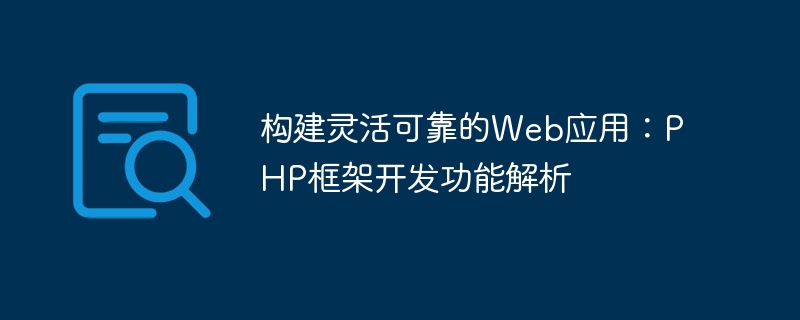
As the Internet continues to develop, Web applications are becoming more and more common. To meet growing demands, developers need to build flexible and reliable web applications. The PHP framework is a solution for web application development that provides powerful features to simplify the development process and improve the maintainability of the application. This article will analyze the development of PHP framework from a functional perspective.
- MVC Architecture: Model-View-Controller (MVC) is a commonly used software architecture that divides an application into three parts: model, view, and controller. The model is responsible for processing data operations, the view is responsible for processing page display, and the controller is responsible for processing user requests and control logic. The PHP framework provides an implementation of MVC, helping developers organize various parts of the application in an orderly manner, improving the readability and maintainability of the code.
- Routing: Routing refers to the process of determining which controller a user request should be sent to. The PHP framework provides flexible routing functions, and developers can define routing rules according to their own needs. Routing rules usually include URL patterns and corresponding controllers and methods.
- Database abstraction layer: Web applications often need to interact with databases to store and retrieve data. The PHP framework provides a database abstraction layer that allows developers to perform database operations through a simple API without writing SQL queries directly. This greatly simplifies the development process and improves application portability.
- Form validation: Form validation is an important step to ensure the validity and security of user input. The PHP framework provides built-in form validation capabilities, and developers can validate user input through a series of rules. This includes checking required fields, verifying email, password strength, and more. Using the framework's form validation capabilities, developers can avoid writing duplicate validation code and be able to quickly respond to user input errors.
- User authentication and authorization: Security is crucial for web applications. The PHP framework provides user authentication and authorization functions, and developers can easily implement user registration, login and permission management. This way, developers can focus on the business logic of the application without having to deal with cumbersome authentication and authorization processes.
- Caching: Caching is an effective way to improve the performance of web applications. The PHP framework provides a built-in caching function that can store frequently accessed data in the cache, reducing the number of database accesses and speeding up application response.
- Error handling and logging: Error handling and logging are essential for any complex application. The PHP framework provides error handling and logging functions, so developers can easily track application errors and exceptions and record them in log files. This is very important for application maintenance and troubleshooting.
- Unit testing: Unit testing is a critical step to ensure application quality. The PHP framework provides unit testing functions, and developers can write test cases to verify the correctness of the code. This allows potential problems to be discovered and fixed early and ensures application stability.
To sum up, PHP framework development provides rich functions to build flexible and reliable Web applications. Developers can improve development efficiency, reduce duplication of work, and ensure the quality and security of applications by using the features provided by the framework. As web applications continue to evolve and their needs increase, the development of PHP frameworks will continue to play an important role.
The above is the detailed content of Build flexible and reliable web applications: analysis of PHP framework development functions. For more information, please follow other related articles on the PHP Chinese website!






